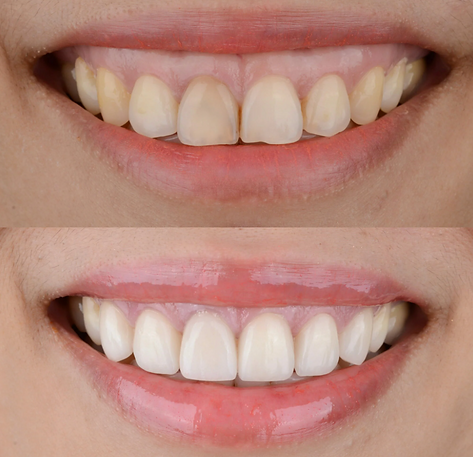
Gummy Smile

A gummy smile is simply a unique feature that adds character and charm to your expression. Many people find that a little extra gum showing makes a smile look more youthful, friendly, and approachable.
Your smile is uniquely yours, and a gummy smile can add warmth and character that others truly appreciate. However, if you still feel strongly about making a change, Dr. Di Xia (Dr. Dee) is here to help. Through a simple procedure called a gingivectomy, we can gently reshape the gumline to create the balance and look you desire—so you can feel even more confident when you smile.
What Can Cause a Gummy Smile?
Confusion often surrounds a gummy smile, with patients wondering if they caused this situation or if genetics played a role.
Essentially, there are genetic causes for a gummy smile, and prevention is all but impossible in most cases. There are also self-created causes, including the lack of certain types of dental care and hygiene earlier on.
The following common causes can lead to a gummy smile:
Abundant Gum Tissue
A common cause of your gummy smile may be the existence of overly abundant gum tissue. This overabundance can occur when permanent teeth erupt and an overgrowth of gum tissue results. This overgrowth covers too much of those newly protruding teeth, giving you a gummy appearance.
Gum Infection and Inflammation
When the gums become infected, inflammation can occur, resulting in swelling of the gums. The swollen gums cover more of the teeth and make it appear as if you have more gum tissue than you really do. To keep this from happening, maintain good dental hygiene by brushing and flossing daily and scheduling professional dental cleanings at least twice a year.
Hyperactive Upper Lip
Genetics can play another role in the cause of a gummy smile by way of a hyperactive upper lip. This condition occurs when the upper lip muscles and those just underneath the nose are hyperactive. That is, with repetitive overuse, those muscles cause a lift in the lip when you smile, which then exposes more gum tissue.
While these are common causes of a gummy smile, there are others as well, including:
-
Vertical maxillary excess (upper jaw overgrowth), which causes bulging gums
-
Gingival hypertrophy, leading to longer or enlarged gums
-
Facial features, such as a shortened upper lip
-
Smaller teeth, due to a wearing down or genetics
Poor Jaw Alignment (or A Bad Bite)
Inheriting poor jaw alignment or a bad bite can lead to a gummy smile. This condition causes the misalignment of the top jaw with the bottom jaw. If the upper jaw protrudes too far out, it can result in more gums showing when you smile.
How Can a Gummy Smile be Fixed?
While many causes of a gummy smile cannot be prevented, even by practicing good oral hygiene, there are ways to fix them. The best way for you, however, will depend upon the actual cause of your gummy smile.
Common procedures to alleviate you of a smile showing too much gum include the following surgical and non-surgical methods.
Orthodontics
For a mild case resulting from jaw and teeth misalignment, orthodontic treatment is often a solution. Such treatment might include braces or clear aligners like Invisalign. These devices slowly move your teeth into the correct position, fixing the bad bite. As a result, when you smile, less gum tissue will show.
Scaling and Root Planing
A procedure called scaling and root planing is a solution for treating infection and inflammation of the gums. It involves a deep professional cleaning by your dental team that can reach deep into gum pockets at the base of your teeth, followed by a smoothing out of tooth roots to encourage gum reattachment. once the bacteria there is removed, your infection can heal, and the inflammation will subside, relieving that gummy appearance when you smile.
Crown Lengthening (Gingivectomy)
For those with a gummy smile resulting from the overgrowth of gum tissue, crown lengthening, also known as a gingivectomy, is a minimally invasive option. Excess gum tissue is delicately removed, exposing more of your natural teeth. This method is often accompanied by laser contouring procedures and also with the placement of crowns or veneers, which can create a more proportionate look to your teeth and gums.
Laser Gum Contouring
With the use of a laser, your gums can be contoured, resulting in the gum line being moved back. This reshaping of the gumline can eliminate that gummy smile and is minimally invasive. Here at Delicate Dental, we consider a patient’s comfort when recommending laser gum contouring and help you achieve not only a less gummy smile but also keep the harmony going between your teeth and gums overall.
Veneers or Crowns
The addition of crowns or veneers can create an appearance of longer teeth, improving the balance of teeth and gums when you smile. This less-invasive approach is especially helpful to those with shorter teeth due to family genetics or excessive wear.
Veneers or crowns may be a standalone approach or be joined with a laser gum contouring or gingivectomy procedure.
Upper Lip Lowering
Upper lip lowering is actually the removal of a particular section of your gum tissue, followed by the stitching together of the top and bottom of the remaining gum tissues. This surgical procedure creates a shorter look to your lip, allowing it to lift only so high and cover any excessive gums. We will provide the best resource and information to coordinate your treatment with local periodontist.
Lip Repositioning Surgery
For certain cases, you may want to consider lip repositioning surgery. This procedure is exactly what its name implies, with the lip being surgically moved downward to hide more of the gum tissue. This is often a choice for those with a hyperactive upper lip. We will provide the best resource and information to coordinate your treatment with local periodontist.
Botox
One of the newest options to fix a gummy smile is the use of Botox. While commonly used to reduce the appearance of fine lines and wrinkles, it can also reduce excess gum tissue being visible when smiling. It works by restricting the over-contraction of the upper lip muscles, and the injections will need to be repeated every 3-6 months.
Common FAQ
1 / How long does it take to fix a gummy smile?
Gummy smile surgery, depending on the method used, typically takes 1 hour for procedures like crown lengthening or gingivectomy. For most patients, healing time takes 1–2 weeks, when swelling subsides and the gums begin to look more natural. While initial recovery is relatively quick, full gum contour stabilization and final results may take 1–3 months as the tissues remodel and settle. During the first few days, mild soreness and swelling are common, so a soft-food diet and gentle oral care are recommended. By the end of the second week, most people can return to normal eating and brushing, although follow-up visits ensure the gums heal properly.
2 / Does gummy smile surgery hurt?
Gummy smile surgery is often less painful than patients expect. Local anesthesia to ensures your comfort during the treatment. Afterward, gums may feel tender or sore as they heal, but this discomfort is typically mild and temporary.
Over-the-counter pain relievers can help ease any soreness. Most patients find that their gums feel significantly better within one to two weeks. Following post-treatment care instructions, like avoiding hard foods and keeping the area clean, can speed up recovery and reduce discomfort.
3 / Are gummy smile treatment permanent?
The results of gummy smile treatments can be long-lasting, but it depends on the method used. Gum reshaping and surgery offer permanent results since they alter the gum tissue or bone structure. Botox, on the other hand, is a temporary option that lasts about three to six months, requiring touch-ups to maintain the results. Your dentist can help you choose a treatment plan that fits your needs and goals for long-term success.
If you’re exploring options for fixing a gummy smile, a consultation with our dentist is the best place to start. We have many solutions to help you achieve a more confident, balanced smile.
